
It will give you information about latest technologies in India
- Subject:
- Applied Science
- Material Type:
- Data Set
- Date Added:
- 01/09/2017

It will give you information about latest technologies in India

HomeBank is a resource for shared multi-hour, real-world recordings of children’s everyday experiences (for example, daylong home recordings using the LENA system), plus tools for analyzing those recordings. It is a component of the TalkBank system.
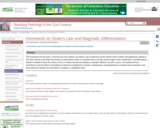
This homework has two parts. In the first part, the students use Stoke's Law to determine (a) the relative sizes of olivine and plagioclase settling at the same velocity (and relate their answer to observations made on cumulate rocks in the lab, (b) the length of time it would take a xenolith-bearing basalt on Hawaii to reach the surface, and (c) to realize that pumice landing on seawater will float, not sink! In part 2, the students fill out a worksheet to see the effects of simultaneous fractional crystallization of olivine, clinopyroxene, and plagioclase on residual melt composition, and then determine whether the melt follows a tholeiitic or calcalkaline trend. The homework involves simple algebra, but several unit conversions and normalization of the results. After the students hand in the homework, we have a class discussion on the assumptions and problems associated with using Stoke's Law to model magmatic processes. We also work with different colored marbles to see the effects of fractional removal of different "minerals" on residual magma composition. My main goal in assigning this homework is to have students see that they can use simple math to come up with results for themselves, and then to have them think about the significance of those results.
(Note: this resource was added to OER Commons as part of a batch upload of over 2,200 records. If you notice an issue with the quality of the metadata, please let us know by using the 'report' button and we will flag it for consideration.)

This homework has 2 main parts: In the first part, students are given bulk compositions for 6 volcanic rocks and asked to classify them, think about their normative compositions, and given likely tectonic settings for three of them. In the second part, they work with a complex binary phase diagram. In this part, they must think about components vs. phases, the lever rule, behavior at a peritectic point, and fractional removal of a phase. After completing this homework, I find that students are comfortable working with any binary diagram I give them.
(Note: this resource was added to OER Commons as part of a batch upload of over 2,200 records. If you notice an issue with the quality of the metadata, please let us know by using the 'report' button and we will flag it for consideration.)

Being able to control the movement of electrons is fundamental for making all electronic devices work. Discover how electric and magnetic fields can be used to move electrons around. Begin by exploring the relationship between electric forces and charges with vectors. Then, learn about electron fields. Finally, test your knowledge in a fun "Electron Shooting" game!
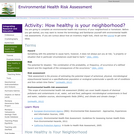
You are going to complete an environmental health risk inventory of your neighborhood or hometown. Before you get started, you may want to review the terminology and familiarize yourself with environmental health risk assessments. If you are curious about how an inventory might look, check out the tutorial to get some ideas.
(Note: this resource was added to OER Commons as part of a batch upload of over 2,200 records. If you notice an issue with the quality of the metadata, please let us know by using the 'report' button and we will flag it for consideration.)
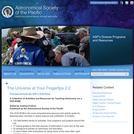
This is a lesson about representative sampling. When given parts of the Hubble Deep Field image, learners will count the number of galaxies in one sample section of the image. Then, they will calculate how many galaxies there are in each whole image and how many objects the Hubble Space Telescope could see in the entire Universe. This is Activity H-6 of Universe at Your Fingertips 2.0: A Collection of Activities and Resources for Teaching Astronomy DVD-ROM, which is available for purchase.
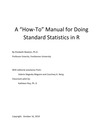
This “How To….” Manual is intended to assist the new user in implementing standard statistical methods, both parametric and non-parametric, using R statistical software. Its focus is on R implementation, not statistical theory. It includes the R commands, with examples, for the following: proportion tests, t-tests, ANOVA, variance tests, several correlation measures and regression models, Mann-Whitney-Wilcoxon tests, Kruskal-Wallis tests, chi-squared tests, multiple pairwise comparisons and effect sizes. Basic graphical methods are also illustrated.

In this 2-part inquiry-based lesson, students conduct a literature search to determine the characteristics of the atmospheres of different planets (Venus, Mercury, Mars and Earth). After collecting and analyzing data, student teams design and conduct a controlled physical experiment using a lab apparatus to learn about the interaction of becomes CO², air, and temperature. The resource includes student worksheets, a design proposal, and student questions. Connections to contemporary climate change are addressed. This lesson is the first of four in Topic 4, "How do Atmospheres Affect Planetary Temperatures?" within the resource, Earth Climate Course: What Determines a Planet's Climate?

In this kinesthetic activity, the concept of energy budget is strengthened as students conduct three simulations using play money as units of energy, and students serve as parts of a planetary radiation balance model. Students will determine the energy budget of a planet by manipulating gas concentrations, energy inputs and outputs in the system in this lesson that supports the study of climate on Mars, Mercury, Venus and Earth. The lesson supports understanding of the real-world problem of contemporary climate change. The resource includes a teacher's guide and several student worksheets. This is the second of four activities in the lesson, How do Atmospheres affect planetary temperatures?, within Earth Climate Course: What Determines a Planet's Climate? The resource aims to help students to develop an understanding of our environment as a system of human and natural processes that result in changes that occur over various space and time scales.

In this activity, students simulate the interaction of variables, including carbon dioxide, in a radiation balance exercise using a spreadsheet-based radiation balance model. Through a series of experiments, students attempt to mimic the surface temperatures of Earth, Mercury, Venus and Mars, and account for the influence of greenhouse gases in atmospheric temperatures. The activity supports inquiry into the real-world problem of contemporary climate change. Student-collected data is needed from activity A in the same module, "How do atmospheres interact with solar energy?" to complete this activity. Included in the resource are several student data sheets and a teacher's guide. This activity is part of module 4, "How do Atmospheres Affect Planetary Temperatures?" in Earth Climate Course: What Determines a Planet's Climate? The course aims to help students to develop an understanding of our environment as a system of human and natural processes that result in changes that occur over various space and time scales.
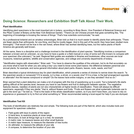
This article, part of Biodiversity Counts, provides insight into the important task of identifying plant specimens. The article includes a list of tools that are part of a botanist's field kit.

In this Biodiversity Counts article, students learn how to preserve their plant pressings.

This lesson plan was created by Stefanie Green as part of the 2020 NDE ELA OER Project. This lesson plan is designed for sophomore students and would most effectively be taught in collaboration between an English teacher and a school librarian. The lesson will take approximately 60 minutes. View the Google Slides presentation here: https://tinyurl.com/yxjz2zpu
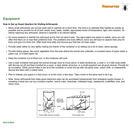
In this Biodiversity Counts activity, students learn how to replicate an arthropod's natural habitat in order to create suitable guest quarters. The online page includes instructions for what to observe in an arthropod's environment, tips for converting a container, such as a soda bottle or aquarium, into a hospitable habitat with plenty of oxygen, water, hiding places, and other arthropod necessities, notes about what to feed the arthropod and where to purchase both arthropods and their food.
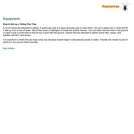
In this Biodiversity Counts activity, students learn how to set up a yellow pan trap to attract insects drawn to the color yellow. The supplies required are readily available.

This online article, from Biodiversity Counts, is a general-purpose tip sheet for using a dichotomous key. The article outlines a three step process using a tree as an example.

The first wave of the Women’s Liberation Movement (also known as “feminism”) occurred during the mid to late-1800s. The main objective was votes for women. In the mid-1960’s, the second wave of feminism appeared with a goal for women to obtain a stronger role in American society. This lesson will examine the second wave of the Women’s Liberation Movement by exploring the changes in the traditional role of women and discovering the role that The Feminine Mystique played in those societal changes. You will discover how the Women’s Movement is still pushing for equality today.StandardsCC.8.5.9-10.D Determine the meaning of words and phrases as they are used in a text, including vocabulary describing political, social, or economic aspects of history/social science.CC.8.6.9-10.G Gather relevant information from multiple authoritative print and digital sources, using advanced searches effectively; assess the usefulness of each source in answering the research question; integrate information into the text selectively to maintain the flow of ideas, avoiding plagiarism and following a standard format for citation.
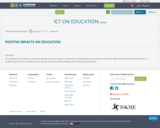
ICT enables the students to learn new things at various aspects of learning. It helps them top overcome with many difficulties in matters of studying - to understand various concepts or to create any practical understanding of the theoretical learning.
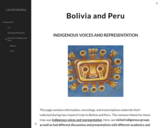
This page contains information, recordings, and transcriptions materials that I collected during two research trips to Bolivia and Peru. The common theme for these trips was Indigenous voices and representation. Here, I visited indigenous groups as well as had different discussions and presentations with different academics and social activist in these two countries. I hope that the information and materials here are helpful to everybody that visit this page. Click on the links below to access the materials per country.
If you use any of this information for a class, please feel free to share your lesson plan with me so that I can post it. In this way, other instructors/teachers/professors can also use these materials. The goal is to make all of these materials and lesson plans accessible.
Here are the recordings of the interviews, talks, and different explanation of some traditions and stories*, **. Each section is divided by subject as well as location.
The recordings are number for ease of access.
The transcripts for each recording can be found at the end of this page, inside the file folders.
*This data collection was possible thanks to the Fulbright Hays Group Abroad Projects (2016) funding with Oakton College.
**The sub-section of High Andes within the "Interviews and Talks" section was collected thanks to the LACC's US Department of Education Title VI Grant (2023) funding with FIU.